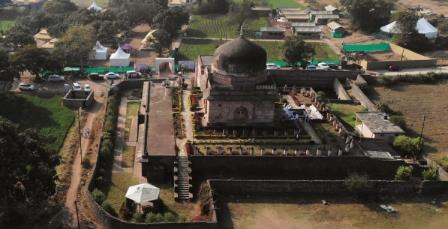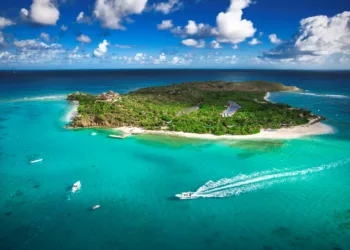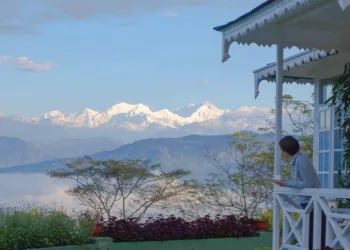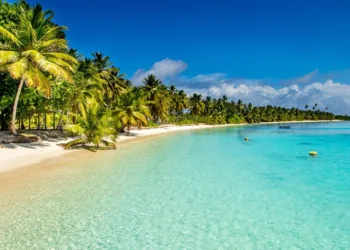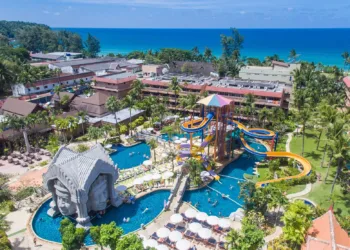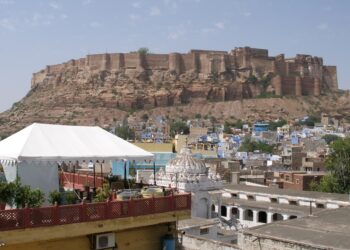The Mandu Festival combines the natural and historical attractions of Mandu with food, art, adventure and an array of activities. Add this to your list of reasons to travel to India in the winter. Mandu has been included in UNESCO’s tentative list of world heritage sites
BY SYED SAAD AHMED
From the sky, Mandu’s Jami Masjid looks different. On the ground, its sloping buttresses catch your eye, but from high above, its multitude of domes stand out. There are three massive domes surrounded by a sea of smaller ones that cover its entire roof. But I can’t admire these features for long. I am in a hot-air balloon and the strong wind is pushing us away from the plateau to the forested valley.
Experiences like these are the draw of the Mandu Festival, organised by Madhya Pradesh Tourism and event management company E-Factor Entertainment. While I had earlier been to Mandu, a two- to threehour drive from Indore in central India, the festival presents its plethora of attractions in novel, offbeat contexts.
You can enjoy an unparalleled vantage point over its hills, forests and monuments from a hot-air balloon. You can enter a meditative
trance to the sounds of Tibetan singing bowls and didgeridoos amid medieval ruins. A crumbling yet stately tomb sprouting tufts of grass becomes the backdrop for music and dance performances. An orchard in the middle of fields transforms into the venue of a feast of local cuisine and rotis straight from the hearth. Under an arched door with stone lattices, a storyteller narrates the legends of Baz Bahadur and
Roopmati to the sound of a flute.
Baz Bahadur, the 16th-century ruler of Mandu, did not build any grand structures, but he is the name associated most with the town. After all, his legacy is greater than mere brick and mortar—love. The story goes that on a hunting trip, the king came across the shepherdess Roopmati, whose singing bewitched him. They got married and had a blissful coupledom until Mughal emperor Akbar sent his forces to capture Mandu. As with all the great historical love stories—Romeo and Juliet, Laila and Majnu—the ending is dismal: the city fell to the Mughals and Roopmati killed herself. And that’s why, even after 500 years, Mandu remains synonymous with the illfated lovers.
Bharti Dixit, a storyteller from Indore, has been narrating the couple’s tale at the festival since its 2019 edition. She says, “Their story is relevant even today because it teaches us about love. Mandu stands as a symbol of their love.”
That’s perhaps why Mandu has often been listed among the most romantic cities in India. It certainly is during the monsoon, which brings thick mists that lend the landscape and monuments a dreamy air. But it is a different kind of picturesque during the winter, when the festival happens. The strong sunshine and cool winds give you expansive views that are hard to come by during the monsoon. The vegetation turns from lush green to amber, seemingly aglow against the clear, blue skies. The romance persists, regardless of the season.
Along with love, there’s plenty of lust, as I realise during the heritage walks organised by the festival. Our knowledgeable guide, Naveen, explained the elaborate water harvesting, filtration and storage systems in the 15th-century Jahaz Mahal. But controversy and laughter erupted when he mentioned that the king who built the palace, Ghiyasuddin Khalji, had 15,000 wives. What’s more, he had constructed a ‘gym’ nearby (the steps of the present-day Ashrafi Mahal) for his corpulent concubines to exercise in.
I initially ascribed this legend to his lurid imagination, but later found out that Mughal emperor Jehangir had started this rumour in his memoi —almost two centuries after Ghiyasuddin’s death! The truth is that Ghiyasuddin was atypical for his time. He established a madrasa for the women of his harem. They learnt warfare, hunting, archery, theology and philosophy and often enjoyed greater wealth and status than male nobles.
Beyond the monuments, Mandu has plenty of natural wonders. Some events of the festival are held at the Dino Adventure Park & Fossils Museum, a 10-minute drive from Mandu. While the venue could charitably be described as aesthetically challenged, it offers sweeping views of the Kakra Kho gorge, where waterfalls gush during the monsoon. The museum’s fossilised dinosaur eggs, nests, sea creatures (millions of years ago, the region was underwater) and a 70-million-year-old tree are exciting to behold, but their upkeep is disappointing.
During the festival, an Art and Craft District has been set up next to Sagar Lake, the largest water body in Mandu. Anup Shrivastav, whose canvases are on exhibit there, says, “We have paintings, installations and live craft demonstrations by about 30 artists from Indore, Dhar and other places near Mandu. There is contemporary as well as traditional art, such as the Gond and Pithora paintings of the region’s adivasis.”
Himanshu Lodwal, Durgesh Bithare, Mona Sharma, Aman Tekam and Aditya Chadar are some of the artists whose works are on display. The one that captivates me most is Avdhesh Yadav’s installation, Filled with Void. It is inspired by a custom he came across while cycling in western Madhya Pradesh: the selling of oil in small, clear plastic bags. Hundreds of bags hang from ropes at the edge of the lake next to a centuries-old bridge. The installation is worth visiting twice. At night, the plastic glimmers in the lights; in the sunshine, you can see it in its entirety, which reveals different facets.
When you’re done with all the gallivanting, you can take refuge in glamping. E-Factor Entertainment has set up luxurious tents with four-poster beds, en-suite dressing rooms, bathrooms and verandahs.
Jai Thakore, the founder and COO of E-Factor Entertainment, says, “Visitors can enjoy the tent city until the end of February. We want to make the festival and the tents a regular fixture, so that tourists can have a holistic experience that goes beyond just a day trip to see Mandu’s main monuments.”
Indeed, even the three days I spend at the festival are not enough to discover all the delights Mandu has. What next, you ask? The seven-km trek to Budhi Mandu, an archaeological site with hundreds of sculptures and ruins.
@syedsaadahmed


